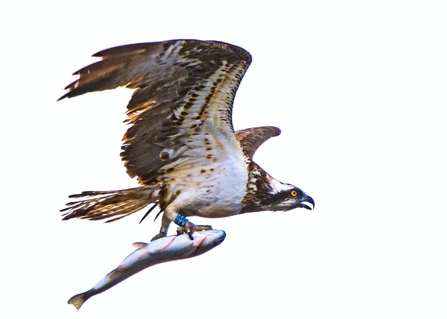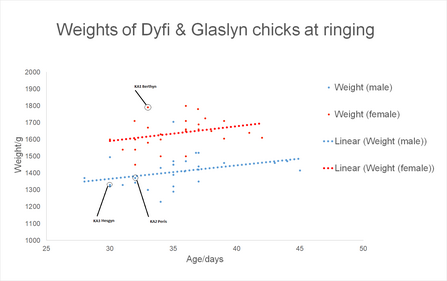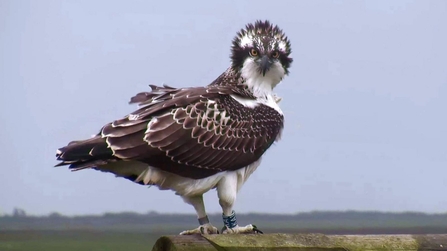We have the photo of Berthyn back in Scotland!
Here she is.... Please take note this was taken in May 2021, near Kinross, Scotland.
We have the photo of Berthyn back in Scotland!
Here she is.... Please take note this was taken in May 2021, near Kinross, Scotland.

Berthyn. © Peter Brown
Q. Why do we see more male ospreys than females returning?
A. The male and female osprey reproductive ratio is 50:50 and their mortality rate is about the same too, so there will be no differences in the numbers of males and females on a population level.
In total this century, 29 Welsh osprey offspring have been re-spotted back as adults - 31% (n9) of these from the Dyfi nest. Of these 29 Welsh returnees, 76% (n22) have been males, but only 24% (n7) have been females. So what accounts for this disparity?
In a word: Behaviour.
Berthyn was one of three in 2019 with two brothers.

Berthyn is also the second heaviest bird we've recorded at this nest.

Males are much more nomadic when they are back as two and three-year olds, visiting various nests, many of which have cameras (in Wales - four in all). We have the old philopatric behaviour to thank for this.
Females are, on the whole, less mobile. They will be less conspicuous to us humans, preferring to look out for males on nests that are advertising for a female vacancy.
You also have the 'Scottish factor'.
If females returning to Wales don't see a vacancy, rather than hang around in their ancestral colony as many males do (this is the philopatry bit - Aeron, Tegid, Dinas etc..) they will keep on moving (north mostly) until they find an eligible male. And that usually means northern England or Scotland.
Some of the forests in Scotland are absolutely massive. Once a female starts to breed there, the chances of spotting her is remote at best.
Just look at Telyn's behaviour right now.... If she was nesting deep in a national park in Scotland with no roads or access, she would never be found.
So - if there are 22 Welsh males accounted for as having returned as adults - the laws of probability tells us there will be a corresponding number of females. We know of seven, so chances are there are another 15 or so out there (22 - 7).
Thing is, they are incredibly difficult to spot.
Many thanks to Peter Brown for his great image of Berthyn taken last year. If she has settled down as a three-year-old and is breeding this year, we may never see her again. Very best of luck to you Berthyn.
You may possibly hear her though!
Berthyn on the Dyfi nest in 2019 - she was a big, noisy girl!

Berthyn. © MWT